Transylvania
Transylvania | |||||||
|---|---|---|---|---|---|---|---|
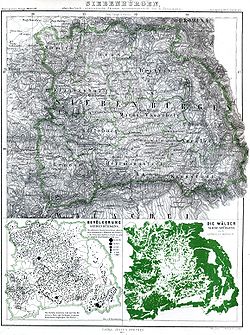 Map of the Great Principality of Transylvania (1857) | |||||||
| Capital | Cluj-Napoca, Alba-Iulia | ||||||
| Common languages | Romanian (official language), Hungarian, German (minorities' languages only) | ||||||
| History | |||||||
• Established | 1075 | ||||||
• Disestablished | 1918 | ||||||
| |||||||


Transylvania (Romanian: Ardeal or [Transilvania] Error: {{Lang}}: text has italic markup (help); Hungarian: Erdély; Template:Audio-de; Template:Lang-la. In other languages: Template:Lang-pl or [Transylwania] Error: {{Lang}}: text has italic markup (help); Template:Lang-bg; Serbian: Трансилванија / [Transilvanija] Error: {{Lang}}: text has italic markup (help) or Ердељ / [Erdelj] Error: {{Lang}}: text has italic markup (help); Turkish: Erdel) is a historical region in present-day central Romania. Outside Romania, it is strongly associated with the novel Dracula,[1][2][3] while within Romania and Hungary the region is known for the scenic beauty of its Carpathian landscape and its rich historic heritage.
Etymology
Transylvania was first referred to in a Medieval Latin document in 1075 as ultra silvam, meaning "exceedingly forested" (ultra meaning "excessively or beyond what is common" and the accusative case of sylva (sylvam) meaning "wood or forest").
The modern English name is probably taken from the Hungarian Erdély, which is derived from Erdő-elve meaning "beyond the forest" (a meaning first referred to in its Medieval Latin version in a 12th century document - Gesta Hungarorum). "Transylvania" means "beyond the forest" (trans meaning "across, over, beyond").
The German name Siebenbürgen means "seven fortresses", after the seven (ethnic German) Transylvanian Saxons' cities in the region (Kronstadt, Schäßburg, Mediasch, Hermannstadt, Mühlbach, Bistritz and Klausenburg). This is also the origin of many other language's name for the region, such as the Polish siedmiogród.
The origin of the Romanian name Ardeal is controversial. The first known occurrence of the Romanian name appeared in a document in 1432 as Ardeliu.[4] It may be a borrowing of the Hungarian name Erdély, as is the Romani name Ardyalo - in old Hungarian, Erdély was pronounced as Erdél. The initial e- in Hungarian occasionally changes to a in Romanian (cf. Hung. egres "gooseberry" and Egyed, which became agriş and Adjud in Romanian). Another hypothesis is that the name is a result of an elision from thewords aur and deal (gold and hill, respectively), resulting in Ardeal from the composed word Aur-deal. It may also take its origin from the Khazar word “Ardil-land” (Hebrew „Eretz Ardil”, „ארדיל”), from the Celtic "Arduenna" (forest), reflected in other names such as Arda, Ardal, Ardistan, Ardiche, Ardennes, Ardelt and Ardilla, or from the Sanskrit Har-Deal.
See also other languages.
History
In its early history, the territory of Transylvania belonged to a variety of Empires and States, including Dacia, the Roman Empire, the Hun Empire and the Gepid Kingdom[5]. There were also periods when autonomus political entities raised under the control of the Byzantine and the Bulgarian Empire[6]. As a political entity, (Southern) Transylvania is mentioned from the 12th century as a county(Alba) of the Kingdom of Hungary (M. princeps ultrasilvanus - comes Bellegratae). Transylvania's seven counties were brought under the voivode's (count of Alba Iulia) rule in 1263. It then became an autonomous principality under nominal Ottoman suzerainty in 1571. A few centuries later, in 1688, it was added to the expanding territories of Habsburg Monarchy, then became again a part of the Kingdom of Hungary within the newly established Austro-Hungarian Empire in 1867. Since World War I, it has been part of Romania, apart from a brief period of Hungarian occupation during World War II.
Cluj-Napoca is today considered to be the region's spiritual capital, although Transylvania was also ruled from Alba Iulia during its period as an autonomous principality within the Ottoman Empire, and from Sibiu, where the Habsburg governor was located from 1711 to 1848. The seat of the Transylvanian Diet was itself moved to Sibiu for some time in the 19th century.
Since medieval times, the population of the region has been a mixture of ethnic Romanians (historically known as Vlachs), Hungarians, the Székely (a separate Hungarian-speaking nation), Germans (known as Saxons), Armenians (especially in Gherla (Armenopolis), Gheorgheni and Tarnaveni), Jews and Roma (known as Gypsies or "tatars" - Tatern in Transylvanian Saxon or tătăraşi in Romanian).
The Ancient Kingdom of Dacia and Roman Rule
The Kingdom of Dacia was in existence at least as early as the beginning of the 2nd century BC, and it reached its maximum extent under the rule of Burebista. The area now constituting Transylvania was the political center of the ancient kingdom, where several important fortified cities were built, among them Sarmizegetusa, near today's Hunedoara.
In 101-102 and 105-106, Roman forces under the Emperor Trajan fought a series of military campaigns to subjugate Dacia. After the suicide of the Dacian ruler Decebalus, parts of Dacia were incorporated into the Roman Empire, this being traditionally considered the starting moment for the birth of the Romanion nation. During Hadrian (117-135) the current territory of Transylvania was included in Dacia Superior. During Antoninus Pius (138-161) the same territory was included in the provinces Dacia Porolissensis (capital at Porolissum) and Dacia Apulensis (capital at Apulum).The Romans built mines, roads and forts in the province. Colonists from other Roman provinces were brought in to settle the land and cities like Apulum (now Alba Iulia), Napoca (now Cluj-Napoca), Ulpia Traiana Sarmizegetusa and Aquae appeared. During the Roman administration also Christianity entered the current territory of Transylvania from the neighbouring Roman provinces where according to the tradition of the Romanian Orthodox Church St. Peter preached.
The Dacians from outside the Roman Empire attacked frequently, and due to increasing pressure from the Visigoths, the Romans abandoned the province during the reign of the Emperor Aurelian in 271. As across much of Europe, a period of chaos and conquests followed after the collapse of Roman rule. However, as shown by the archeological research, many of the Roman cities continued to exist, building fortifications. Also Christianity survived as proved by the many artifacts discovered. Among the most famous is the donarium from Biertan (4th century) having the inscription 'Ego Zenovius votvm posui' (I, Zenovie, offered this). The territory fell under the control of the Visigoths and Carpians until they were in turn displaced and subdued by the Huns in 376, under the leadership of their infamous warlord Attila. After the disintegration of Attila's empire, the Huns were succeeded by Gepids of Eurasian Avar descent. The region was also influenced during this period by massive Slavic immigration.
At the beginning of the 9th century, Transylvania, along with eastern Pannonia, was under the control of the First Bulgarian Empire[citation needed]. After a brief period of Bulgarian rule, the territory, partially under Byzantine control, was slowly incorporated (following 200 years of fights with local lords) into the Kingdom of Hungary.[citation needed]
Transylvania in the Kingdom of Hungary
At the begining of the 9th century the Hungarian tribes, coming from the Eastern Urals, were located in the north of the Black Sea. Around 895-896 they established in Pannonia and started to expend their territories towards east, where current Transylvania was located. According to Gesta Hungarorum, an Hungarian medieval document describing among others the conquest of Transylvania, three statal structures were encountered, ruled by Menumorut, Glad and Gelu. The region ruled by Duke Menumorut was laying from Transylvania to Mures and Somes and had the capital at Biharea. Glad ruled from Mures to Orsova Castrum, and he was succeeded by Ahtum, who was killed during the time of King Stephen I of Hungary. Duke Gelu the Romanian (originally Blacus in Gesta Hungarorum which means Romanian) was ruling over Transylvania and had his capital at Dabica. The Hungarians requested first to Menumorut to surrender his territory claming succession of Attila the Hun who ruled over the territory centuries before. Menumorut replied that he only recognized the authority of the Emperor from Constantinopole and the conflict. After defeating Menumorut at the Meses battle the Hungarians moved forward and conquered the territory of Gelu who died fighting. The conquest of Transylvania took around 200 years, the Hungarians reaching Eastern Carpethians during King Bela III (1172-1196). The early 11th century was marked by the conflict between King Stephen I of Hungary and his uncle Gyula, the ruler of Transylvania. The Hungarian ruler was successful in these wars, and Transylvania became part of the Kingdom of Hungary. The Transylvanian Christian bishopric and the comitatus system were organised. By the 12th century the ethnic Hungarian Székely were established in eastern and southeastern Transylvania as a border population of ready warriors, and in the 12th and 13th centuries, the areas in the south and northeast were settled by German colonists called Saxons. Romanians maintained control over a few autonomous regions called 'terrae': Fagaras, Amlas. Hateg, Maramures, Lapus. However the autonomy was taken by the end of Arpadian dinasty in 1301.
In 1241-1242, during the Mongol invasion of Europe, Transylvania was among the territories devastated by the Golden Horde. A large portion of the population perished. This was followed by a second Mongol invasion in 1285, led by Nogai Khan.
Following this devastation, Transylvania was reorganized according to a class system of Estates, which established privileged groups (universitates) with power and influence in economic and political life, as well as along ethnic lines. The first Estate was the lay and ecclesiastic aristocracy, ethnically heterogeneous, but undergoing a process of homogenization around its Hungarian nucleus. The other Estates were Saxons, Szeklers and Romanians (or Vlachs - Universitas Valachorum), all with an ethnic and ethno-linguistic basis (Universis nobilibus, Saxonibus, Syculis et Olachis). The general assembly (congregatio generalis) of the four Estates had few genuine legislative powers in Transylvania, but it sometimes took measures regarding order in the country.

A key figure to emerge in Transylvania in the first half of the 15th century was Ioannes Corvinus (Iancu de Hunedoara, John Hunyadi). His military campaigns against the Ottoman Empire brought him the status of Transylvanian governor in 1446 and papal recognition as the Prince of Transylvania in 1448.
After the suppression of the Budai Nagy Antal-revolt in 1437, the political system was based on Unio Trium Nationum (The Union of the Three Nations). According to the Union, which was explicitly directed against serfs and other peasants, society was ruled by three privileged Estates of the nobility (mostly ethnic Hungarians), the Székelys, also an ethnic Hungarian people who primarily served as warriors, and the ethnic German, Saxon burghers.
The only possibility for Romanians to retain or access nobility in Hungarian Transylvania was through conversion to Catholicism. Some Orthodox Romanian nobles converted, becoming integrated into the Hungarian nobility. These circumstances marked the beginning of a conflict between ethnic Hungarian Catholics and ethnic Romanian Orthodox in the territory of Transylvania which in some regions remains unresolved to this very day.[7]
Transylvania as an Independent Principality

The 16th century in Southeastern Europe was marked by the struggle between the Muslim Ottoman Empire and the Catholic Habsburg Empire. After the Ottoman Sultan Suleiman the Magnificent overran central Hungary (see Ottoman Hungary), Transylvania became a semi-independent principality where Austrian and Turkish influences vied for supremacy for nearly two centuries. It is this period of independence and Turkish influence that contributed to Transylvania being seen as exotic in the eyes of Victorians such as Bram Stoker, whose novel Dracula was published in 1897.[8]
Due to the fact that Transylvania was now beyond the reach of Catholic religious authority, Protestant preaching such as Lutheranism and Calvinism were able to flourish in the region. In 1568 the Edict of Turda proclaimed four religious expressions in Transylvania - Catholicism, Lutheranism, Calvinism and Unitarianism, while Orthodoxy, which was the confession of the Romanian population, was proclaimed as "tolerated" (tolerata).
The Báthory family began to rule Transylvania as princes under the Ottomans in 1571, and briefly under Habsburg suzerainty until 1600. The latter period of their rule saw a four-sided conflict in Transylvania involving the Transylvanian Báthorys, the emerging Austrian Empire, the Ottoman Empire, and the Romanian voivoideship (province) of Wallachia. This included a brief period of Romanian rule after the conquest of the territory by Wallachian voivod Michael the Brave. As he subsequently extended his rule over Moldavia, Michael the Brave unified for the first time in history all the territories where Romanians lived.
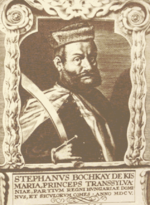
The Calvinist magnate of Bihar county Stephen Bocskai managed to obtain, through the Peace of Vienna (June 23, 1606), religious liberty and political autonomy for the region, the restoration of all confiscated estates, the repeal of all "unrighteous" judgments, as well as his own recognition as independent sovereign prince of an enlarged Transylvania. Under Bocskai's successors, Transylvania passed through a golden age for both many religious movements and for the arts and culture. Transylvania became one of the few European States where Roman Catholics, Calvinists, Lutherans and Unitarians lived in peace, although Orthodox Romanians continued to be denied equal recognition.
Within the Habsburg Empire
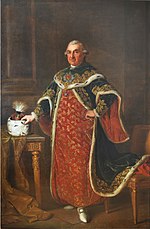
After the defeat of the Ottomans at the Battle of Vienna in 1683, the Habsburgs gradually began to impose their rule on the formerly autonomous Transylvania. Apart from strengthening the central government and administration, the Habsburgs also promoted the Roman Catholic Church, both as a uniting force and also as an instrument to reduce the influence of the Protestant nobility. In addition, they tried to persuade Romanian Orthodox clergymen to join the Greek (Byzantine Rite) Catholic Church in union with Rome. As a response to this policy, several peaceful movements of the Romanian Orthodox population advocated for freedom of worship for all the Transylvanian population, most notably being the movements led by Visarion Sarai, Nicolae Oprea Miclăuş and Sofronie of Cioara.
From 1711 onward, the princes of Transylvania were replaced with Austrian governors and in 1765 Transylvania was declared a grand principality.
The revolutionary year 1848 was marked by a great struggle between the Hungarians, the Romanians and the Habsburg Empire. Warfare erupted in November with both Romanian and Saxon troops, under Austrian command, battling the Hungarians led by the Polish born general Józef Bem. He carried out a sweeping offensive through Transylvania, and Avram Iancu managed to retreat to the harsh terrain of the Apuseni Mountains, mounting a guerrilla campaign on Bem's forces. After the intervention by the armies of Tsar Nicholas I of Russia, Bem's army was defeated decisively at the Battle of Timişoara (Temesvár, Hun.) on 9 August 1849.
Having quashed the revolution, Austria imposed a repressive regime on Hungary, ruled Transylvania directly through a military governor and granted citizenship to the Romanians.
The 300-year long special separate status came to an end by the Austro-Hungarian Compromise of 1867, which established the dual monarchy and reincorporated Transylvania into the Kingdom of Hungary. On 20 June 1867, the Diet was dissolved by royal decree, and an ordinance abrogated the legislative acts of the Cluj-Napoca provincial assembly. The department of the interior inherited the responsibilities of the Transylvanian Gubernium, and the government reserved the right to name Transylvania's royal magistrates as well the Saxon bailiff of the Universitas Saxorum. Hungarian legislation also came to supersede the Austrian code of civil procedure, penal law, commercial law, and regulations for bills of exchange. The new unity of Austria-Hungary created a process of Magyarization affecting Transylvania's Romanians and German Saxons.
As Part of Romania

Since the Austro-Hungarian empire had begun to disintegrate after the end of World War I, the nationalities living inside proclaimed their independence from the empire. The 1228-member National Assembly of Romanians of Transylvania and Hungary, headed by leaders of Transylvania's Romanian National Party and Social Democratic Party, passed a resolution calling for unification of all Romanians in a single state on 1 December in Alba Iulia.[9] This was approved by the National Council of the Germans from Transylvania and the Council of the Danube Swabians from the Banat, on 15 December in Mediaş. In response, the Hungarian General Assembly of Cluj reaffirmed the loyalty of Hungarians from Transylvania to Hungary on December 22, 1918. (See also: Union of Transylvania with Romania)
The Treaty of Versailles placed Transylvania under the sovereignty of Romania, an ally of the Triple Entente, and the Treaty of St. Germain (1919) and the Treaty of Trianon (signed in June 1920) further elaborated the status of Transylvania and defined the new border between the states of Hungary and Romania.[10][11] King Ferdinand I of Romania and Queen Maria of Romania were crowned at Alba Iulia in 1922 as King and Queen of all Romania.
In August 1940, the second Vienna Award granted the northern half of Transylvania to Hungary. After the Treaty of Paris (1947), at the end of World War II, the territory was returned to Romania. The post-WWII borders with Hungary, agreed on at the Treaty of Paris, were identical with those set out in 1920.
After World War II and especially after the fall of Communism, Transylvania lost almost all of the German-speaking population, most of whom have emigrated to Germany.
Historical coat of arms of Transylvania
The Diet of 1659 codified the representation of the privileged nations in Transylvania's coat of arms. It depicts:
- A black turul on a blue background, representing the medieval nobility, which was primarily Magyar.
- The Sun and the Moon representing the Székelys.
- Seven red towers on a yellow background representing the seven fortified cities of the Transylvanian Saxons
(The red dividing band was originally not part of the coat of arms.)
-
Coat of Arms of 1659
-
Landesfarben of Transylvania in Austria-Hungary, reflecting the tinctures of the coat-of-arms
-
As part of the coat of arms of Hungary before the Treaty of Trianon in 1920
-
As in the coat of arms of Romania at present
Geography and ethnography

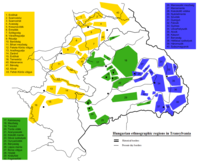
The Transylvanian plateau, 300 to 500 metres (1,000-1,600 feet) high, is drained by the Mureş, Someş, Criş, and Olt rivers, as well as other tributaries of the Danube. This core of historical Transylvania roughly corresponds with nine counties of modern Romania. Other areas to the west and north, which also united with Romania in 1918 (inside the border established by peace treaties in 1919-20), are since that time widely considered part of Transylvania.
See also Administrative divisions of the Kingdom of Hungary. In common reference, the Western border of Transylvania has come to be identified with the present Romanian-Hungarian border, settled in the Treaty of Trianon, although geographically the two are not identical.
Administrative divisions
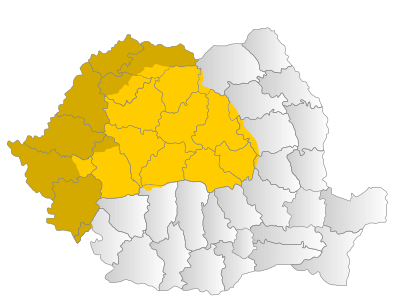
Light yellow – historical region of Transylvania
Dark yellow – historical regions of Banat, Crișana and Maramureș
Grey – historical regions of Wallachia, Moldavia and Dobruja
The historical region covers 16 present-day counties (Romanian: judeţ) which include nearly 103,600 km² of central and northwest Romania. The 16 counties are:
- Alba
- Arad
- Bihor
- Bistriţa-Năsăud
- Braşov
- Caraş-Severin
- Cluj
- Covasna
- Harghita
- Hunedoara
- Maramureş
- Mureş
- Sălaj
- Satu Mare
- Sibiu
- Timiş
The most populous cities are:
- Cluj-Napoca (318,027)
- Timişoara (317,651)
- Braşov (283,901)
- Oradea (206,527)
- Arad (172,824)
- Sibiu (155,045)
- Târgu Mureş (149,577)
- Baia Mare (137,976)
- Satu Mare (115,630)
Population
Historic definitions of Transylvania vary geographically. The 2002 Romanian census classified Transylvania as the entire region of Romania west of the Carpathians. This region has a population of 7,221,733, with a large Romanian majority (74.69%). There are also sizeable Hungarian (19.60%), Roma (3.39%), German (0.73%) and Serb (0.1%) communities. [12] [13] The ethnic Hungarian population of Transylvania, largely composed of Székely, form a majority in the counties of Covasna and Harghita.
For people connected to Transylvania's cultural life see: List of Transylvanians.
Economy
Transylvania is rich in mineral resources, notably lignite, iron, lead, manganese, gold, copper, natural gas, salt and sulfur.
There are large iron and steel, chemical, and textile industries. Stock raising, agriculture, wine production and fruit growing are important occupations. Timber is another valuable resource.
Transylvania accounts for around 35% of Romania's GDP, and has a GDP per capita (PPP) of around $11,500, around 10% higher than the Romanian average.
Tourist attractions
- The medieval cities of Alba Iulia, Cluj-Napoca, Sibiu (European Capital Of Culture-2007) , Târgu Mureş and Sighişoara
- The city of Braşov and the nearby Poiana Braşov ski resort
- The city of Hunedoara with the 14th century Hunyadi Castle
- The citadel and the Art Nouveau city centre of Oradea
- The Wooden Churches of the Maramureş region
- The Dacian Fortresses of the Orăştie Mountains, including Sarmizegetusa
- The Saxon fortified churches
- Hungarian traditions and folk culture
- The cafe culture [3], street theatre and cosmopolitan society of Sibiu
-
Orthodox Cathedral in Timişoara
-
Arad cultural center
-
Arad Evangelical church
-
Black Church in Braşov
-
Braşov Council Square (Piaţa Sfatului)
-
The Theatre in Oradea
-
The town hall in Oradea
-
Dacia Hotel in Satu Mare
-
View of Sibiu
-
Sighişoara clock tower
-
View of Sighişoara
-
The Catholic Cathedral in Timişoara
Transylvania in fiction
Transylvania's long history of Muslim Turkish influence[clarification needed], as well as its late industrialization (which meant that in the late 19th century, Transylvania was still mostly covered with wilderness[citation needed]), created an orientalist fascination with the region by a number of notable Victorian writers. Following the publication of Emily Gerard's The Land Beyond the Forest (1888), Bram Stoker wrote his gothic horror novel Dracula in 1897, using Transylvania as a setting. Due to the success of the latter work, Transylvania became associated in the English-speaking world with vampires. Since then it has been represented in fiction and literature as a land of mystery and magic. For example, in Paulo Coelho's novel The Witch of Portobello, the main character, Sherine Khalil, is described as a Transylvanian orphan with a Romani mother, in an effort to add to the character's exotic mystique. The so-called Transylvanian triology of historical novels by Miklos Banffy, The Writing on the Wall, is an extended treatment of the 19th and early 20th century social and political history of the country.
References
- ^ Transylvania Society of Dracula Information
- ^ [http:/THIS /query.nytimes.com/gst/fullpage.html?res=9F0CE6DE143BF931A1575BC0A965958260 TRAVEL ADVISORY; Lure of Dracula In Transylvania - New York Times]
- ^ Romania Transylvania
- ^ Pascu, Ştefan (1972), Voievodatul Transilvaniei, vol. I, p. 22
- ^ Béla Köpeczi (editor). "History of Transylvania". Atlantic Research and Publications, Inc. Retrieved 2007-01-29.
{{cite web}}:|author=has generic name (help) - ^ 6. SOUTHERN TRANSYLVANIA UNDER BULGAR RULE
- ^ Romania Confronts Transylvanian Separatism
- ^ ELENI COUNDOURIOTIS, Dracula and the Idea of Europe
- ^ "December 1 - Romania National Day". Honorary Consul of Romania in Boston. Retrieved 2008-01-12.
- ^ Bachman, Robert D. (1989). "Romania: A Country Study". Retrieved 2008-01-12.
- ^ "Trianon, Treaty of". Encyclopædia Britannica. Retrieved 2008-01-12.
- ^ 2002 Census official results: [1]
- ^ Ethnocultural Diversity Resource Centre database:[2]
Further reading
- This article incorporates text from a publication now in the public domain: Chisholm, Hugh, ed. (1911). Encyclopædia Britannica (11th ed.). Cambridge University Press.
{{cite encyclopedia}}: Missing or empty|title=(help) - Patrick Leigh Fermor, Between the Woods and the Water (New York Review of Books Classics, 2005; ISBN 1-59017-166-7). Fermor travelled across Transylvania in the summer of 1934, and wrote about it in this account first published more than 50 years later, in 1986.
- Zoltán Farkas and Judit Sós, Transylvania Guidebook
External links
- RTI Radio - Radio Transsylvania International
- Tolerant Transylvania - Why Transylvania will not become another Kosovo, Katherine Lovatt, in Central Europe Review, Vol 1, No 14 27 September 1999.
- The History Of Transylvania And The Transylvanian Saxons by Dr. Konrad Gündisch, Oldenburg, Germany
- Template:Hu icon Transylvanian Webcatalogue
- Template:De icon Historical Literature about Transilvania and Neighbouring Territories by Klaus Popa, Germany
- Transylvania, its Products and its People, by Charles Boner, 1865
- Template:Hu icon Transylvanian Family History Database

















